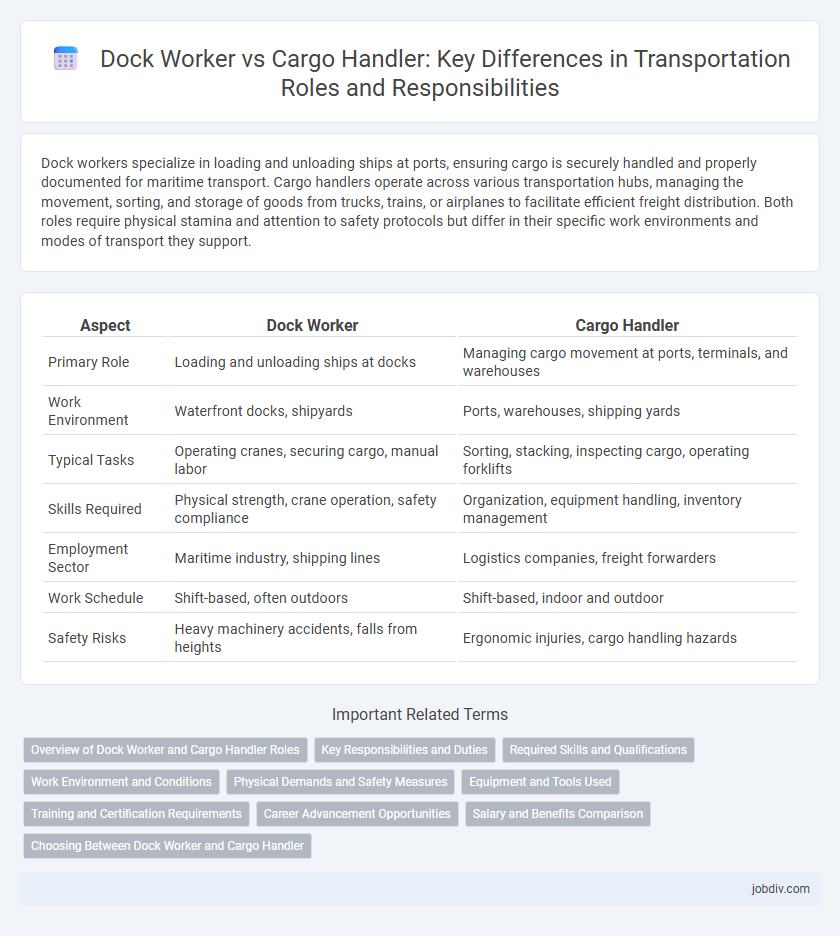Dock workers specialize in loading and unloading ships at ports, ensuring cargo is securely handled and properly documented for maritime transport. Cargo handlers operate across various transportation hubs, managing the movement, sorting, and storage of goods from trucks, trains, or airplanes to facilitate efficient freight distribution. Both roles require physical stamina and attention to safety protocols but differ in their specific work environments and modes of transport they support.
Table of Comparison
| Aspect | Dock Worker | Cargo Handler |
|---|---|---|
| Primary Role | Loading and unloading ships at docks | Managing cargo movement at ports, terminals, and warehouses |
| Work Environment | Waterfront docks, shipyards | Ports, warehouses, shipping yards |
| Typical Tasks | Operating cranes, securing cargo, manual labor | Sorting, stacking, inspecting cargo, operating forklifts |
| Skills Required | Physical strength, crane operation, safety compliance | Organization, equipment handling, inventory management |
| Employment Sector | Maritime industry, shipping lines | Logistics companies, freight forwarders |
| Work Schedule | Shift-based, often outdoors | Shift-based, indoor and outdoor |
| Safety Risks | Heavy machinery accidents, falls from heights | Ergonomic injuries, cargo handling hazards |
Overview of Dock Worker and Cargo Handler Roles
Dock workers primarily load and unload shipments at shipping docks, ensuring cargo is securely transferred between ships, trucks, and warehouses. Cargo handlers manage the sorting, moving, and storage of goods within warehouses or transportation hubs, often operating forklifts and other equipment to efficiently organize freight. Both roles are essential in maintaining the flow of goods within the supply chain, with dock workers focusing on ship-to-shore activities and cargo handlers concentrating on internal logistics and inventory management.
Key Responsibilities and Duties
Dock workers primarily manage the loading and unloading of ships, ensuring cargo is handled safely and efficiently at port terminals. Cargo handlers oversee the movement, storage, and packaging of goods within warehouses or distribution centers, coordinating with transportation teams to optimize supply chain flow. Both roles require adherence to safety regulations and effective communication to maintain operational efficiency in transportation logistics.
Required Skills and Qualifications
Dock workers require physical strength, stamina, and proficiency in operating heavy machinery such as forklifts, along with knowledge of safety regulations and inventory management systems. Cargo handlers need strong organizational skills, attention to detail, and the ability to handle various cargo types carefully, with qualifications often including hazardous materials training and certification in cargo securing techniques. Both roles demand teamwork, effective communication, and adherence to strict safety protocols to ensure efficient loading and unloading processes.
Work Environment and Conditions
Dock workers often operate in outdoor, waterfront environments exposed to varying weather conditions, requiring physical endurance for tasks like loading and unloading ships. Cargo handlers typically work in indoor warehouses or distribution centers with climate control, focusing on organizing and moving goods using machinery. Both roles demand adherence to safety protocols, but dock workers face more exposure to environmental hazards and maritime regulations.
Physical Demands and Safety Measures
Dock workers endure intense physical demands, including heavy lifting, prolonged standing, and repetitive motions, which require stringent safety measures like ergonomic training and protective gear to prevent musculoskeletal injuries. Cargo handlers face similar physical challenges but often operate machinery such as forklifts, necessitating comprehensive safety protocols, including equipment operation certification and adherence to hazard communication standards. Both roles prioritize rigorous workplace safety practices to minimize accident risks while managing the physical rigor of loading, unloading, and securing freight in transportation hubs.
Equipment and Tools Used
Dock workers primarily use forklifts, pallet jacks, and conveyor systems to move and organize cargo efficiently within shipping yards and warehouses. Cargo handlers often rely on cranes, hoists, and specialized loading ramps to manage the transfer of goods between vehicles and storage areas. Both roles require safety equipment such as gloves, helmets, and high-visibility vests to ensure secure handling of materials.
Training and Certification Requirements
Dock workers typically require specialized training in operating heavy machinery such as forklifts and understanding safety protocols for loading and unloading ships, with certification like OSHA forklift certification often mandated. Cargo handlers need comprehensive knowledge of cargo securing techniques, hazardous materials handling, and may require certifications such as the Dangerous Goods Regulations (DGR) training to comply with international shipping standards. Both roles emphasize on-the-job training, but cargo handlers face stricter regulatory requirements due to the nature of transported goods and international regulations.
Career Advancement Opportunities
Dock workers often have clearer pathways to supervisory roles such as dock supervisor or warehouse manager due to their specialized skills in loading and unloading ships. Cargo handlers can advance by gaining certifications in handling hazardous materials or operating heavy machinery, opening opportunities in logistics coordination or safety management. Both careers offer growth potential, but dock workers typically benefit from more structured advancement within port operations.
Salary and Benefits Comparison
Dock workers typically earn an average annual salary ranging from $35,000 to $50,000, while cargo handlers can expect slightly lower wages, averaging $30,000 to $45,000 per year. Benefits for dock workers often include health insurance, retirement plans, and union protections, which may offer greater job security compared to cargo handlers. Cargo handlers may receive similar health benefits but often have fewer unionized opportunities and less comprehensive retirement options.
Choosing Between Dock Worker and Cargo Handler
Choosing between a dock worker and a cargo handler depends on specific job responsibilities and work environments within the transportation sector. Dock workers primarily focus on loading and unloading ships, ensuring cargo is properly secured and accounted for at ports. Cargo handlers manage the movement, storage, and distribution of goods across various transportation modes, emphasizing efficiency in logistics and supply chain operations.
Dock Worker vs Cargo Handler Infographic

 jobdiv.com
jobdiv.com